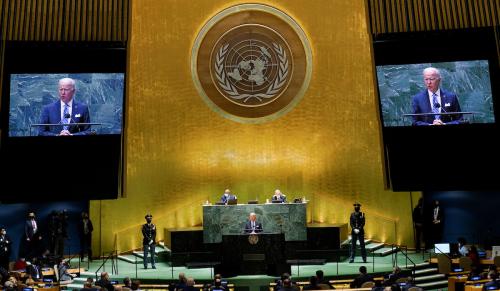On the campaign trail, we are already seeing evidence of the insidious effects of a number of myths about banking. Such myths make for bad policy, even though they are popular with the public, the media, and voters and therefore unlikely to die away. I am particularly worried about three myths that could produce policies that would make it harder for our financial system to fuel economic growth and could increase the risks of future crises despite purporting to make things safer.
Two cautions before I begin. First, there is only enough space here to explain each myth and why it is harmful. I will refer readers who wish to investigate my claims to more detailed analyses. Second, I also have to over-simplify the myths to save space. In most cases, there are more reasoned and nuanced versions of the myths, although I still believe them to be wrong.
Myth #1: Banks that are “Too Big to Fail” are the major risk and should be broken up. There is a reasonable argument that we need to be especially careful in regulating the biggest banks, which are often viewed as “Too Big to Fail,” and therefore could require a government rescue in extreme cases. However, this is often carried too far and turned into an assertion that (a) the core problem which created the Crisis was the existence of mega-banks and that (b) we need to break them up by law in order to eliminate their risks to financial stability.
In brief, there is little reason to believe that the existence of mega-banks was anything close to the largest factor in the Crisis, as illustrated by a small thought experiment. Imagine if all of the biggest banks had been broken up into 10 or 20 pieces each in advance of the crisis. They would almost certainly have collectively made roughly the same mistakes as the mega-banks did. They would have made the same bad housing loans and the same bad commercial mortgages, transformed the bad loans into the same bad, opaque and complicated securitizations, had bonus systems designed in ways that encouraged excessive risk, operated with too little capital and too little liquidity, and made all the other mistakes that the big banks did. Why am I confident in saying this? Because they would have operated in the same markets with the same collective over-confidence and mistaken beliefs and the same incentives. Further the regulators and rating agencies would have made the same mistakes that they did in reality and there would have been the same broader problems, such as loose monetary policy and unsafe housing policies.
Further, breaking up the biggest banks would lose the genuine benefits for our economy of having large, global banks operating at efficient scale across a wide variety of products. For the US to support globally competitive companies we need banks that can meet their needs, which require very large and diverse institutions. There are also a host of practical issues that arise with any break-up plan of this complexity. There would likely be serious economic costs to throwing our largest banks into turmoil for several years in which they would be focused on their break-up, not their customers.
The reality is also that we would not turn these mega-banks into small banks, with all their vaunted virtues. More likely they would be broken into perhaps 5 banks each, all of which would still be large and complex and would act similarly to the mega-banks. Anything more drastic would produce even greater economic costs and would be inconsistent with allowing regional banks to operate, as we have comfortably done for years. For most voters, creating a series of $500 billion banks is not what they envision when they think of breaking up the hated mega-banks.
Finally, the myriad of regulatory reforms contained in Dodd-Frank and international agreements, plus actions taken at the insistence of investors and creditors, have made banks much safer than they were before. This is particularly the case for the mega-banks that are required to have substantially higher safety margins now than other banks do. There are also much better arrangements to handle troubled large banks than existed during the Crisis.
Overall, breaking up the largest banks would destroy substantial economic efficiencies, produce a long transition in which banks would serve their customers badly, and would bring little in the way of additional safety to our system.
Myth #2: Restoring Glass-Steagall would make the system safer. Many people argue that combining securities and derivatives transactions with the traditional bank business of taking deposits and making loans is unsafe. They want to restore some version of the prohibitions under the Glass-Steagall Act that kept “investment banking” (mostly the securities business) from being in the same corporate groups as “commercial banking” (traditional banking.) When posed as keeping the cowboys on Wall Street from infecting banks and taking advantage of federally guaranteed deposits to gamble, it is hard to oppose.
However, there are a number of crippling flaws with the idea. First, the repeal of Glass-Steagall’s anti-affiliation provisions made almost no difference to the terrible financial crisis we just went through. The big failures and near-failures were either at almost pure investment banks (Lehman, Bear Stearns, Merrill Lynch) or almost pure commercial banks (Washington Mutual, Countrywide, Wachovia). Citigroup combined both, but its real problem was that it messed up in both areas, not that they were combined. It is true that the next crisis could be different, but it would be really surprising if Glass-Steagall actually mattered much and yet made so little difference in this awful crisis.
Second, Glass-Steagall was never repealed, just the anti-affiliation provision. This means that banking groups can currently operate both commercial banks and investment banks. However, there are strong limits on how the two sides can work together, meaning that the talk about using depositor money to support gambling in securities generally does not stand up to investigation.
Third, combined groups benefit from the diversification effect of having both businesses together. Usually one side does better than the other in troubled times, reducing the risk of failure. Since the Crisis demonstrated that investment banking failures can be nearly as devastating to the economy as commercial banking failures, there is clear value in diversification to protect both sides. This is a major reason the big failures were in firms with purer focuses.
Fourth, it is almost impossible to figure out where to draw the line between investment banking and commercial banking anymore. Corporate customers clearly want their bankers to be able to help with loans, bond offerings, and all the many derivatives transactions that make it possible to tailor transactions to business needs. That is why proponents usually call for a “New Glass-Steagall” that would reflect the changed business model. However, they usually skip the details or, when they propose them, they have serious flaws. “Traditional banking” for large and medium-sized corporations – the core customers for investment banking — just does not exist anymore; all the pieces are too intertwined, and for good reasons of economic efficiency.
Fifth, the Volcker Rule already outlaws the main problem that Glass-Steagall advocates claim they are trying to solve – the ability to “gamble with depositor money.” Banking groups have very sharply cut back on their inventories of stocks and bonds in response to this rule, so even if you see it as gambling, there is just not that much of it anymore.
Myth #3: Insisting on higher bank safety margins would be costless. There is a very politically attractive argument that banks should be forced to run with much higher safety margins of capital and that this has no societal cost – the safety benefits are free. (Overly-simplified, “capital” is the amount of funds invested by shareholders in a bank. The more the bank has, the more risk is borne by shareholders rather than the bank’s funders or, ultimately, taxpayers.)
At first blush, it seems obvious that higher capital levels come with a cost, since shareholders demand higher returns than depositors or bond buyers, to compensate shareholders for taking the most risk. However, Modigliani and Miller, two Nobel-Prize winning economists, showed years ago that the increased safety that comes with more capital reduces the unit cost of all forms of funding in a way that exactly offsets the use of more of the expensive form – in idealized conditions. Some academics have built on this to argue strongly for much higher levels of required capital and gone so far as to claim that it is free from society’s point of view.
The problem is that the real world is quite different from the idealized conditions that Modigliani and Miller had to assume in their theoretical analysis. I have summarized seven violations of the theoretical conditions in a paper of mine, of which the biggest is that interest payments by corporations have favorable tax treatment compared to dividend payments. These differences substantially reduce the offset and mean that higher capital does cost more. A number of analyses by official organizations have shown that this flows through in the real world to higher borrowing costs for bank customers, including a very recent study from the International Monetary Fund.
To be clear, capital levels at banks were much too low prior to the crisis and I strongly support raising capital levels to those in the internationally-agreed Basel III Accord. However, there are trade-offs in doing this. Credit becomes more expensive and less available. If we raise required capital levels much further than Basel III does, then the trade-offs become unfavorable, as there is little additional safety benefit, but a noticeable cost in terms of credit price and availability. Further, a large additional increase in capital requirements would also shift substantial business away from highly-regulated banks into the so-called “shadow banking” sector, where the risks to financial stability are likely to be worse.



Commentary
Op-edPolitical myths about banking make for bad policy
March 24, 2015